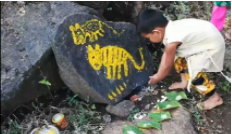
Aboriginals are the indigenous people of India. There are numerous castes and sub castes of the tribal populace which are known for their practices of nature worship. For centuries they have revered water, forests and earth. Many of their customs and traditions represent their belief in Nature.
Today I will introduce you to one such custom or tradition of veneration of a tribe. The tribe is Koli Mahadev or Mahadev Koli. This tribe is secluded in a region situated in the lap of the Sahyadris. Originally the tribe belongs to Maharashtra. In the 1961 census, their population was 2,74,244 but since then they have not been separately surveyed. The people from this tribe are located in the western part of the state, primarily in three districts- Pune, Ahemadnagar and Nasik where they have managed to preserve their culture. The people of the Koli Mahadev tribe worship trees in the forest around them considering them their gods and goddesses and adorning them with names like- Kalmajamata, Varsuai, Ghorapada Devi, Kalsuai etc. They also adore the wildlife and pay respect to their cattle on a special festival. For example- Oxen are worshipped on the occasion of Bail Pola, which is celebrated by the tribal folk. Another such customary practice of the Koli Mahadev people which I will talk about is Vagh baras is an annual rite which has been passed through generations, where the lion is worshipped, and the people offer him kheer (a sweet dish made from rice and milk). The lion is ritually treated with rice, vermillion (kumkum), shedur or sindoor, turmeric(haldi), incense sticks, oil and lamp made out of mud.
The Koli Mahadev people prepare a stone after washing it and draw a lion’s image from sindoor (ochre colored), annually, in a specially demarcated space. In front of the image are kept fives leaves from a tree, on which the kheer made from freshly harvested rice is served, and the incense and lamp are lit.

The people believe that lion is the king of the jungle, thus the pastoralists in order to protect their cattle from the lion, venerate him. The worship takes place every year on the second day of Kartik Ekadashi. The basic practice of drawing the lion on a stone and offering him food remains the same, with changes in other aspects in different areas. Protection of the lions thus goes hand in hand with this tradition which has defied them. An onlooker might misread the tradition; one might see it as idolatry by the aboriginals who are characterised as nature-worshippers. Here one might fail to understand the fact that tribes have followed naturism since the early periods and will continue to do so. The underlying wish is to have Nature’s blessings so that their crops and cattle prosper and thrive.
I would like to conclude here with a message to all- acknowledge the customs and traditions of the aboriginals, respect them and contribute in their conservation.
Thank You!
Jai Bharat, Jai Aadim, Jai Aadivasi, Jai Raghoji, Jai Birsa!!!
This is a translated version of a Hindi piece written by the author. If you wish to read the original Hindi version, please click here
This article is brought to you in collaboration with Sthalantar Foundation. For more information on their work, visit
Instagram
or
YouTube

Jalindhar Maruti Ghane
Jalindhar Maruti Ghane has completed his MBA-Rural Management from IIHMR University, Jaipur. Prior to his MBA Jalindhar has completed the Certificate Programme in Rural Livelihood of Bharat Rural Livelihood Foundation. He has vast knowledge of tribal culture, beliefs and livelihood. Jalindar is working as Young Professional in Rajasthan Grameen Ajeevika Parishad (RGAVP) in Dungarpur district of Rajasthan.


Great goods from you, man. I’ve take into account your stuff prior to
and you are simply extremely fantastic. I really like
what you’ve received right here, really like what you are saying and the way
by which you assert it. You make it entertaining and you continue to take care of to stay it wise.
I cant wait to read far more from you. This is actually a great web site.
What I wouldnt give to have a debate with you about this. You just say so many things that arrive from nowhere that Im pretty sure Id have a fair shot. Your weblog is wonderful visually, I mean people wont be bored. But others who can see past the videos and the layout wont be so impressed together with your generic understanding of this subject.